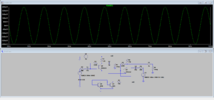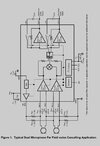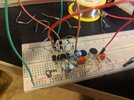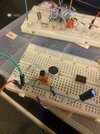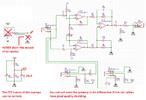Fluffyboii
Active Member
Hi,
A year ago or so I made a microphone preamp with tl071 when I wasn't very good at making electronic circuits. It used a lithium ion battery, a boost converter to boost that up to 30V or something like that and feed that to the op amp which was audioguru's design which had a middle point so that op amp could function with a single sided supply. It was pain to get it working without noise that was generated from the boost converter and everyone was telling me to use one or two 9V batteries but I didn't want it because 9V batteries suck and they are expensive. But at the end, my rechargeable setup use to last 1 week with a single charge and it was working fine. I used it for a long time with both electret and dynamic microphones. Unfortunately my father lost it while "organizing" my stuff while I was at college so I don't know where it is.
Anyway at the dorm I use a single electret microphone that is directly connected to a USB-C to 3.5mm jack converter with an extension cable like this for the sake of easy usage when I rarely need it:

This works because sound card inside the converter provides some DC voltage about 2.1V to the microphone and it's internal amplifier has barely enough gain to make it sound acceptable when sensitivity is full on my computer without software boosting. Of course not all sound cards like this setup. From my experience any USB to 3.5mm sound card works with something like this but integrated ones that are in desktops and laptops have low gain so additional software boost is required which makes it sound awful. But all sound cards I tested had 2-3V bias in them so if there was a way to use that voltage for an amplifier that went between the mic and the sound card while biasing the mic as well it could be improved greatly.
For example the extension cable I use picks up some AC signal from my desk lamp because we still use flourecent lamps at dorms. If I used a differential amplifier I would be technically able to get rid of it while giving me extra gain and possibly sound quality. And this idea unfortunately got stuck in my head.
I don't want to look for low voltage op amps since they are usually work as low as 2.5V but I did not come across something with 2V min working voltage and with the single sided supply it would be even worse. So I started looking for a full discrete design.
When I checked the output of this capsule It was peaking about 100mV. Since I technically don't need additional gain with my sound card I can keep the gain low on the diff amp and focus on getting good CMMR. I immediately realized it wouldn't be possible to amplify 100mV signal with a amplifier that had no feedback since it would clip to a nice square wave. So I used some feedback to both increase input resistance and decrease the gain to something about 4 with 20K input resistors. If I find a 22k double pot for example I can make the gain adjustable on both inputs and maybe even make it be useful for dynamic mics that require much more gain. I do have 1M double pots so maybe tapering (putting parallel resistor with pot) could work?
For now with no input resistors to decrease gain it gets about 35 times max gain. CMMR is about 50dB which is more than enough. Current consumption is quite low about 250uA at 2V so hopefully sound card output will be able to feed it. I messed around with values a little and found something like this is ideal.

It works well with different input voltages. I am aware that I can replace bottom right transistor with a voltage divider and if I build this in real life I may make it with a trimpot for better adjustment. Load resistors can be replaced with PNP transistors to perhaps increase open loop gain but as it is I find it satisfactory.
Two important questions I have right now before trying this on a breadboard or something like that.
How will I get differential output from electret mic.

I saw this and I wonder if I can pick a resistor value to get something I can apply at the two inputs. Or can I use two electret microphones to get two similar signals. But if I used two mics that gave the same output it would be cancelled by the differential amplifier so one of them would need a 180 degree phase shift. Can these problems be relieved?
Second is getting the output. Should I use one of the differential outputs like a single ended output. Or should I have another circuit to convert differential to single ended output? I think I am only losing gain if I do the first one.
I think for making this work with a dynamic mic which requires about 200 times gain I would need PNP transistors or another stage too boost the gain. At that point I would have litteraly made a bad op amp that tolerates low voltages.
Even if I can't make this directly work without any batteries from the sound card I can always connect 2AA batteries to it I guess.
LM386 looks similar at the input side ignoring the darlington pairs. I started seeing differential amplifiers everywhere after learning about it. Are they they useful?

A year ago or so I made a microphone preamp with tl071 when I wasn't very good at making electronic circuits. It used a lithium ion battery, a boost converter to boost that up to 30V or something like that and feed that to the op amp which was audioguru's design which had a middle point so that op amp could function with a single sided supply. It was pain to get it working without noise that was generated from the boost converter and everyone was telling me to use one or two 9V batteries but I didn't want it because 9V batteries suck and they are expensive. But at the end, my rechargeable setup use to last 1 week with a single charge and it was working fine. I used it for a long time with both electret and dynamic microphones. Unfortunately my father lost it while "organizing" my stuff while I was at college so I don't know where it is.
Anyway at the dorm I use a single electret microphone that is directly connected to a USB-C to 3.5mm jack converter with an extension cable like this for the sake of easy usage when I rarely need it:
This works because sound card inside the converter provides some DC voltage about 2.1V to the microphone and it's internal amplifier has barely enough gain to make it sound acceptable when sensitivity is full on my computer without software boosting. Of course not all sound cards like this setup. From my experience any USB to 3.5mm sound card works with something like this but integrated ones that are in desktops and laptops have low gain so additional software boost is required which makes it sound awful. But all sound cards I tested had 2-3V bias in them so if there was a way to use that voltage for an amplifier that went between the mic and the sound card while biasing the mic as well it could be improved greatly.
For example the extension cable I use picks up some AC signal from my desk lamp because we still use flourecent lamps at dorms. If I used a differential amplifier I would be technically able to get rid of it while giving me extra gain and possibly sound quality. And this idea unfortunately got stuck in my head.
I don't want to look for low voltage op amps since they are usually work as low as 2.5V but I did not come across something with 2V min working voltage and with the single sided supply it would be even worse. So I started looking for a full discrete design.
When I checked the output of this capsule It was peaking about 100mV. Since I technically don't need additional gain with my sound card I can keep the gain low on the diff amp and focus on getting good CMMR. I immediately realized it wouldn't be possible to amplify 100mV signal with a amplifier that had no feedback since it would clip to a nice square wave. So I used some feedback to both increase input resistance and decrease the gain to something about 4 with 20K input resistors. If I find a 22k double pot for example I can make the gain adjustable on both inputs and maybe even make it be useful for dynamic mics that require much more gain. I do have 1M double pots so maybe tapering (putting parallel resistor with pot) could work?
For now with no input resistors to decrease gain it gets about 35 times max gain. CMMR is about 50dB which is more than enough. Current consumption is quite low about 250uA at 2V so hopefully sound card output will be able to feed it. I messed around with values a little and found something like this is ideal.
It works well with different input voltages. I am aware that I can replace bottom right transistor with a voltage divider and if I build this in real life I may make it with a trimpot for better adjustment. Load resistors can be replaced with PNP transistors to perhaps increase open loop gain but as it is I find it satisfactory.
Two important questions I have right now before trying this on a breadboard or something like that.
How will I get differential output from electret mic.
I saw this and I wonder if I can pick a resistor value to get something I can apply at the two inputs. Or can I use two electret microphones to get two similar signals. But if I used two mics that gave the same output it would be cancelled by the differential amplifier so one of them would need a 180 degree phase shift. Can these problems be relieved?
Second is getting the output. Should I use one of the differential outputs like a single ended output. Or should I have another circuit to convert differential to single ended output? I think I am only losing gain if I do the first one.
I think for making this work with a dynamic mic which requires about 200 times gain I would need PNP transistors or another stage too boost the gain. At that point I would have litteraly made a bad op amp that tolerates low voltages.
Even if I can't make this directly work without any batteries from the sound card I can always connect 2AA batteries to it I guess.
LM386 looks similar at the input side ignoring the darlington pairs. I started seeing differential amplifiers everywhere after learning about it. Are they they useful?
Attachments
Last edited:

